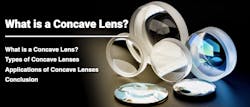Concave lenses are one of the many lenses used in optics. They help create some of the most important equipment you use in your everyday life. These lenses come in various types and have plenty of applications. This article contains all you need to know about concave lenses, such as the different types and how they are applied.
What Is a Concave Lens?
A concave lens bends light inward so that the resulting image is smaller and more vertical than the original. Furthermore, it can create an actual or virtual image. Concave lenses contain at least one face that is curved inward. Another name for these lenses is diverging lenses, and this is because they bulge outward at their borders and are spherical in their centers, causing light to spread out rather than focus.
Types of Concave Lenses
Bi-Concave Lenses
These types of lenses are also called double-concave lenses. Both sides of a bi-concave lens have equal radius curvature and, similar to plano-concave lenses, can deviate from incident light.
Plano-Concave Lenses
A plano-concave lens works like a bi-concave lens. However, these lenses have one flat face and one concave. Furthermore, plano-concave lenses have a negative focal length.
Convexo-Concave Lenses
A convexo-concave lens has one convex surface and one concave surface. That said, the convex surface has a higher curvature than the concave surface, which leads to the lens being thickest in the center.
Applications of Concave Lenses
Corrective Lenses
Correction of myopia (short-sightedness) typically involves the use of concave lenses. Myopic eyes have longer than average eyeballs, which causes images of a distant object to be projected onto the fovea instead of the retina.
Glasses with concave lenses can fix this by spreading the incoming light out before reaching the eye. In doing so, the patient can perceive further away objects with more clarity.
Binoculars and Telescopes
Binoculars allow users to see distant objects, making them appear closer. They are constructed from convex and concave lenses. The convex lens zooms in on the object, while the concave lens is used to focus the image properly.
Telescopes function similarly in that they have convex and concave lenses. They are used to observe extremely distant objects, such as planets. The convex lens serves as the magnification lens, while the concave lens serves as the eyepiece.
Lasers
Laser beams are used in a variety of devices, including scanners, DVD players, and medical instruments. Even though lasers are incredibly concentrated sources of light, they must be spread out for usage in practical applications. As a result, the laser beam is widened by a series of tiny concave lenses, allowing for pinpoint targeting of a specific location.
Flashlights
Flashlights also make use of concave lenses to increase the output of the light they use. Light converges on the lens’ hollowed side and spreads out on the other. This broadens the light’s beam by expanding the source’s diameter.
Cameras
Camera manufacturers frequently utilize lenses that possess concave and convex surfaces to enhance image quality. Convex lenses are the most used lenses in cameras, and chromatic aberrations can occur when they are used. Fortunately, this issue can be solved by combining concave and convex lenses.
Peepholes
Peepholes, often called door viewers, are safety features that allow a full view of what’s on the other side of a wall or door. While looking at an object or area, a concave lens will make it appear smaller and provide a wider perspective.
Conclusion
Well, there you have it. All there is to know about concave lenses. They are lenses with at least one surface curved inward. These lenses are able to bend light inward and make images appear upright and smaller. You can find them used in several contraptions, such as cameras, flashlights, telescopes, and others.
